Stories
Plummer & Co
1878-1972
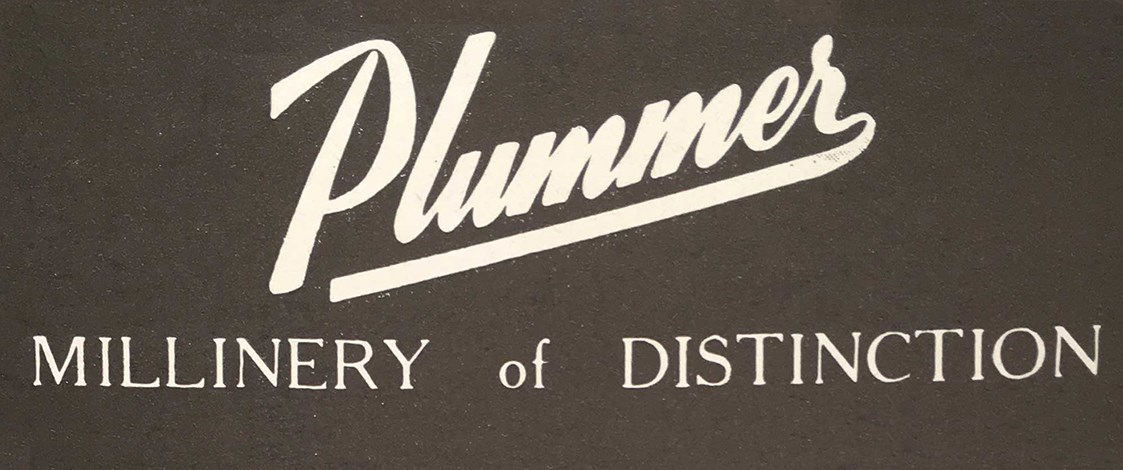
Charles Plummer and his brother George grew up in Luton in England which was the centre of a flourishing hat-making industry. Throughout the 19th century, most of their relatives were involved in various aspects of the millinery business. But the brothers turned their back on the trade and sailed to New Zealand intent on taking up farming.
They were part of the group of Albertlanders who planned to start a non-conformist utopia at Port Albert on the Kaipara Harbour. Charles and George arrived in New Zealand on the Matilda Wattenbach in 1862. Charles was 24 years old.
Few of the new migrants had any agricultural experience, and after some trying years, most of the original settlers ended up in Auckland and reverted to their original trades.
Charles had spent a few years on his farm before he married Leah Hemus, the daughter of another Albertlander. In about 1877 the couple moved south to Auckland and established the Plummer Hat Company.
The company was originally located in Coburg Street in Auckland (now Kitchener Street), before moving to Lorne Street about the turn of the century.
Their son, Charles Bernard (born in 1869 and known as Bertie) joined the family business. He spent time in Luton in 1889 to gain more experience of the trade and travelled frequently to Australia for business. When Charles died in 1897, Bertie took over the business. That same year he married Clara Crowther, a daughter of William Crowther, a Member of Parliament for Auckland City and formerly Mayor of Auckland. In 1908-9 they built the house at 5 City Road, which is still there today. Their home wasn't far from Plummers' new premises at 10 Rutland Street.
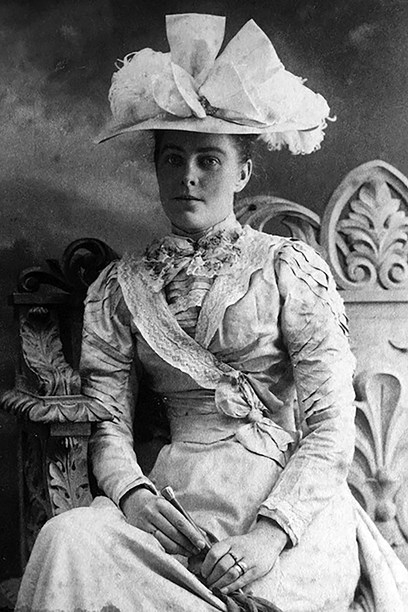
Clara Plummer, presumably wearing a hat designed by her husband's company, circa 1905.
When Plummer Hats was established in the late 1870s, designers looked to Paris and Luton for inspiration. Six decades later, Bertie acknowledged the influence of the New York and Hollywood scenes on 1930s era fashion. "A hat shape known as the 'Janet Gaynor' was one of last winter’s leading styles. This hat appeared in one of Janet Gaynor’s pictures."
He admitted that it was not always easy to predict the leading styles. "Recognising this difficulty we last year sent our General Manager, Mr L Webber, on a trip to Europe and the United Stated to go fully into the question of fashions, the result being that he was able to make arrangements for new leading shapes, both in hats and blocks, to be shipped to us immediately."
In a 1938 radio interview (8 December 1938), Bertie talked of the value of investment in staff training - the machinists, blockers and trimmers. "Young New Zealanders have proved themselves very apt at learning what has now developed into a highly artistic and skilled industry."
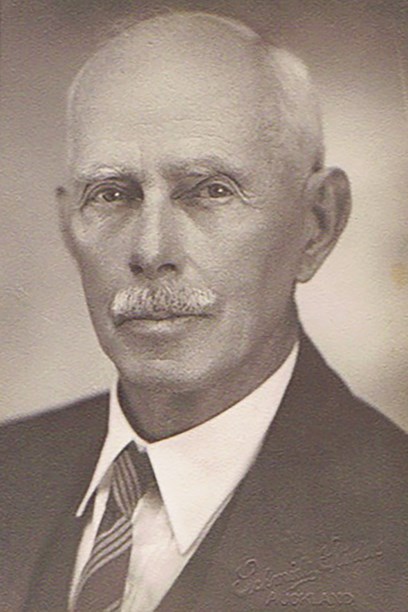
In a 1938 radio interview, Bertie Plummer spoke of the difficulty of predicting seasonal millinery fashion.
At this time, staff at Plummer Hats used three main kinds of machinery - sewing machines, blocking presses and special polishing tools that gave the 'Peachbloom' effect to felt hats.
Before the advent of sewing machines, braiding was sewn by hand into straw hats. The leading makers were Wilcox and Gibbs for chain stitch and the Wiseman box machine for imitating hand stitching. This machine was revolutionary and enabled makers to produce some beautiful work.
Bertie added that skill with the blocking press gives the hats their 'Hallmark'. Blockers at Plummer Hats used Keston press machines; their first was imported about 1887.
The trimmers put the final touches to the blocked hats. They added the ribbons, feathers and ornaments that contribute to making the perfect hat.
The materials for hats at this time were imported from overseas. Straw braids came from China and Japan and exotic hoods were imported from Manila and Java. Real Panamas were made in Central America. Felt and velour hoods, rather than straw, were worn in winter in New Zealand. These were imported from England, France, Austria, Slovakia, Canada and Italy.
The company thrived, despite serious fires in 1897, 1915 and 1930. Plummer and Company Ltd was formed in 1919. The name recognised the diversification of the business to include the manufacture of other garments.
After Bertie’s death in 1944 the company continued under a succession of managers, despite the existence of three daughters. To reflect the diversification of the business, Plummers operated from two separate locations.'Frocks' were manufactured in the Bradford Building at 27-29 Elliott Street, a few doors down from another frock manufacturer Reslau Frocks. 'Hats' were based in a four-storied building several blocks away at 73 Lorne Street.
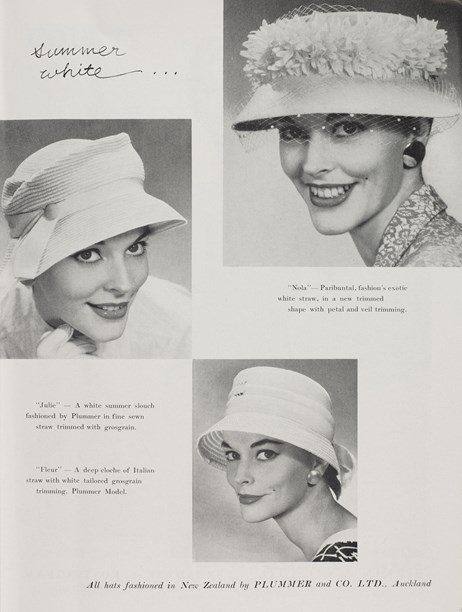
An editorial page for 'summer white' Plummer Hats from Vogue New Zealand, Summer 1959. Image © Conde Nast Publications. Image courtesy of Hocken Collections, Uare Taoka o Hākena, University of Otago.
As the demand for hats declined worldwide, the 'Mantle' department became more important, supplying upmarket garments to mostly more mature customers. However, as women of all ages began wearing more casual clothes it was belatedly decided that diversification was needed. Moorcraft Knitwear was formed, in conjunction with an English firm, but it closed down rapidly when the parent company went into liquidation. There was also a brief foray into babywear.
In 1969 the company moved for the last time - to 35-37 Airedale Street. A new manager, Michael Grace, closed down the millinery department in 1971. He launched the youth label, MIXI Gear, but it struggled to compete with the established brands. There was also a cheaper range launched for summer, called Eve’s Leaves, and they briefly operated a retail store in the new St Lukes shopping centre.
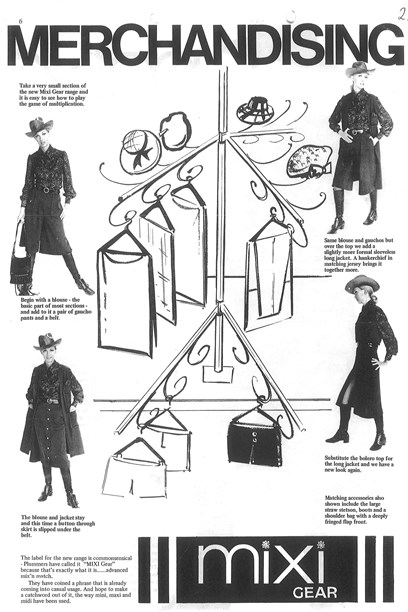
As the demand for hats dried up, Plummer & Co diversified into garment manufacturing under the label MIXI Gear. Image © Plummer & Co.
Shareholders injected yet more capital into the business, but by the end of 1972 it seems the writing was on the wall and Plummer & Co closed down soon after. Bertie’s prediction in 1938 that "our little country has a tremendous future for its secondary industries, while working hand in hand with our friends in the primary industries" ended for Plummer after almost a century in business.
Text by Prue Johns. Banner image Plummer Hats advertisement, 1963.
Last published September 2017.